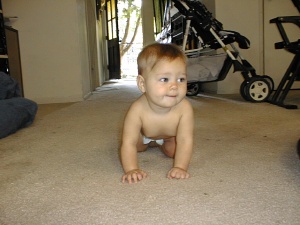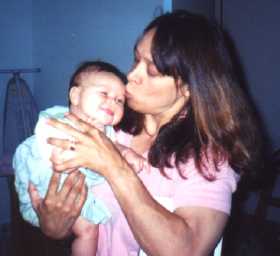Some things you should know at the end of this lesson:
- Social referencing
- Attachment
- Maternal responsivity and sensitivity
 SOCIAL REFERENCING is the term for the way that infants
(and older people, as well, if we are honest about it) take their cues
from others in deciding what emotions and actions are appropriate. How
do infants learn to be afraid of something? One way is their own experience,
but that experience is very limited. A second way is by looking at how
other people react. If a child's mother reacts with fear to mice, snakes
and spiders, it is likely the child will come to fear them as well, even
if he or she has never been bitten by one
SOCIAL REFERENCING is the term for the way that infants
(and older people, as well, if we are honest about it) take their cues
from others in deciding what emotions and actions are appropriate. How
do infants learn to be afraid of something? One way is their own experience,
but that experience is very limited. A second way is by looking at how
other people react. If a child's mother reacts with fear to mice, snakes
and spiders, it is likely the child will come to fear them as well, even
if he or she has never been bitten by one
AN example of Social referencing-- here
Julia looks to her father for a cue as to whether it is safe to chase after
the cat. According to research reviewed in your textbook, if he looks frightened,
she is likely to stop, but if his facial expression is excited or amused
she is more likely to continue crawling after it.----->
(In case you are interested, this worked exactly as the research predicted.
He laughed, she chased after the cat and Smokey (the cat) narrowly escaped
through the open door.
A True (& Not Very Nice) Story about Social Referencing and Racism A friend of mine who grew up in the south (though I am not sure that's relevant) told me that she had learned at a very young age to be afraid of black men. She said, "I don't recall my mama ever saying to me, 'Now, that's a black man, you be afraid of him.' It was just the way she pulled me closer to her, held my hand tighter, put me and her purse on the other side of her when a black man walked by that let me know that, in our family, at least, we are supposed to be afraid of black men - and I was, for all of the time I was a child, and didn't even know why. No black man had ever done anything to hurt me, but I was afraid of them.
 Attachment has been defined as an affectional
bond that endures across space and time.A definition I like better is "the
recognition of one person as special among all others." For example, if
your mother walked into a crowded classroom and sat down, you would have
an emotional response - physiologically, your arousal level would increase
- if you were almost asleep, you would suddenly begin to pay a little more
attention to what was going on around you. There would most likely be a
psychological response; you would feel surprised and somewhat pleased to
see your mom. On the other hand, none of the rest of the people in the
room would notice her at all.
Attachment has been defined as an affectional
bond that endures across space and time.A definition I like better is "the
recognition of one person as special among all others." For example, if
your mother walked into a crowded classroom and sat down, you would have
an emotional response - physiologically, your arousal level would increase
- if you were almost asleep, you would suddenly begin to pay a little more
attention to what was going on around you. There would most likely be a
psychological response; you would feel surprised and somewhat pleased to
see your mom. On the other hand, none of the rest of the people in the
room would notice her at all.
Infants who are 'securely attached' have successfully developed what Erikson referred to as trust.(See your textbook for a description of the different types of attachment).
Secure attachment is related to successful adjustment later in life, from showing less aggression and fewer behavior problems in preschool to better relationships as an adult.
One book I like on the correlation of attachment with later personality development is If this is love, why do I feel so insecure?"
Click here for an optional (but very interesting link) to the web page for the author of this book.
CLICK HERE TO GO TO THE NEXT (AND LAST) PAGE
ON INFANT DEVELOPMENT